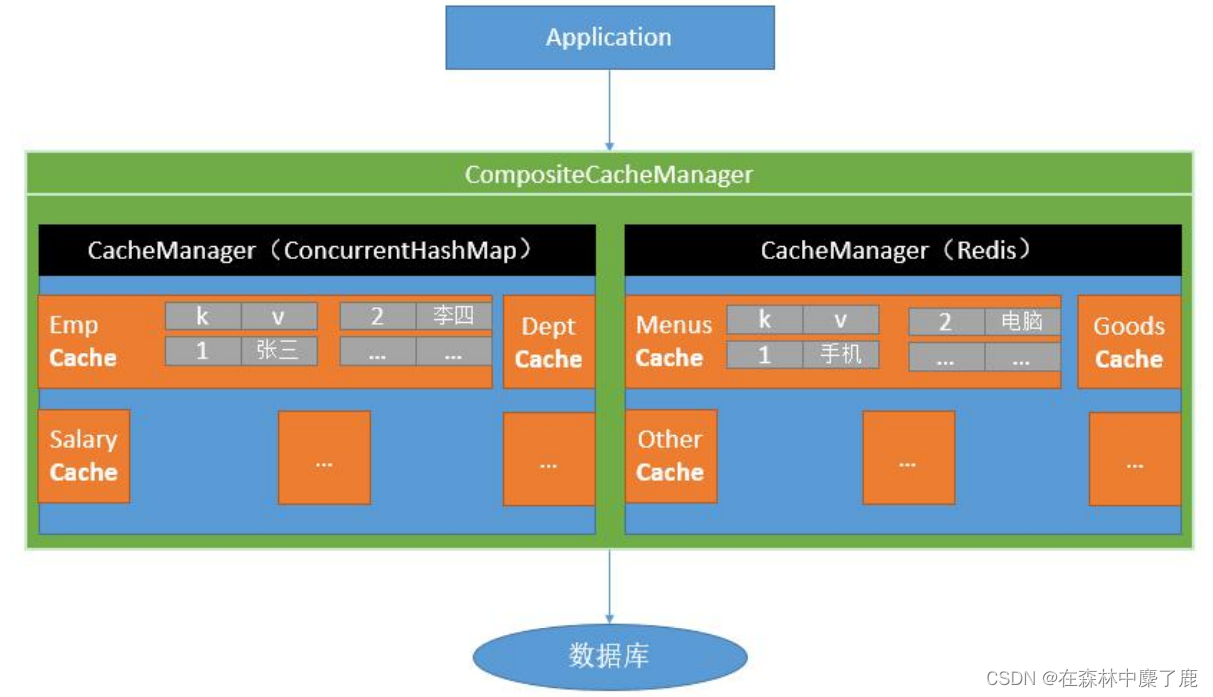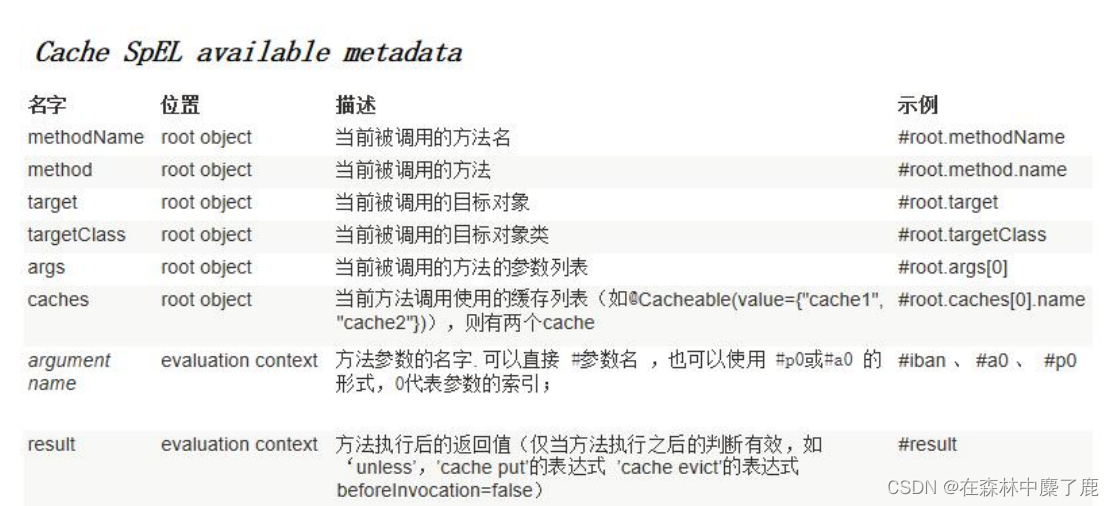一、简介
Spring 从 3.1 开始定义了 org.springframework.cache.Cache 和 org.springframework.cache.CacheManager 接口来统一不同的缓存技术,并支持使用 JCache (JSR-107) 注解简化我们开发。
Cache 接口为缓存的组件规范定义,包含缓存的各种操作集合,Cache 接口下 Spring 提供了各种 xxxCache 的实现 :如 RedisCache ,EhCacheCache, ConcurrentMapCache 等。
每次调用需要缓存功能的方法时,Spring 会检查检查指定参数的指定的目标方法是否已经被调用过。如果有就直接从缓存中获取方法调用后的结果,如果没有就调用方法并缓存结果后返回给用户。下次调用直接从缓存中获取。
使用 Spring 缓存抽象时我们需要关注以下两点:
- 1、确定方法需要被缓存以及他们的缓存策略
- 2、从缓存中读取之前缓存存储的数据
基础概念

二、注解
| 注解 | 说明 |
|---|---|
| Cache | 缓存接口,定义缓存操作。实现有:RedisCache、EhCacheCache、ConcurrentMapCache等 |
| CacheManager | 缓存管理器,管理各种缓存(Cache)组件 |
| @Cacheable | 主要针对方法配置,能够根据方法的请求参数对其结果进行缓存 |
| @CacheEvict | 清空缓存 |
| @CachePut | 保证方法被调用,又希望结果被缓存。 |
| @EnableCaching | 开启基于注解的缓存 |
| keyGenerator | 缓存数据时key生成策略 |
| serialize | 缓存数据时value序列化策略 |
@Cacheable / @CachePut / @CacheEvict 主要的参数
| 参数 | 说明 | 示例 |
|---|---|---|
| value | 缓存的名称, 在 spring 配置文件中定义, 必须指定至少一个 | 例如:@Cacheable(value=“mycache” 或 @Cacheable(value=“cache1”, “cache2”) |
| key | 缓存的key,可以为空,如果指定,按照 SpEL 表达式编写,如果不指定,则缺省按照方法的所有参数进行组合 | @Caheable(value=“testcache”, key=“#username”) |
| allEntries(@CacheEvict) | 是否清空所有缓存内容,缺省为false,如果指定为 true,则方法调用后将立即清空所有缓存 | 例如:@CachEvict(value=“test”, allEntries=true) |
| beforeInvocation(@CacheEvict) | 是否在方法执行前就清空,缺省为false,如果指定为true,则在方法还没有执行的时候就清空缓存,缺省情况下,如果方法执行抛出异常,则不会清空缓存 | 例如: @CacheEvict(value=“testcache”, beforeInvocation=true) |
| unless(@CachePut、@Cacheable) | 用于否决缓存的,不像 condition,该表达式只在方法执行之后判断,此时可以拿到返回值 result 进行判断。条件为 true 不会缓存,false才缓存 | 例如:@Cacheable(vlaue=“testcache”, unless=“#result==null”) |
三、SpEL 语法

四、使用
1. 引入依赖
<dependency>
<groupId>org.springframework.boot</groupId>
<artifactId>spring-boot-starter-cache</artifactId>
</dependency>
2. 写配置
A、自动配置了哪些 ?
CacheAuroConfiguration会导入 RedisCacheConfiguration;
自动配好了缓存管理器RedisCacheManager
B、配置使用redis作为缓存
spring.cache.type=redis
C、也可以自定义配置,因为默认的使用 JDK 的序列化机制,我们想用 JSON 序列化机制
package com.fancy.gulimall.product.config;
import org.springframework.boot.autoconfigure.cache.CacheProperties;
import org.springframework.boot.context.properties.EnableConfigurationProperties;
import org.springframework.cache.annotation.EnableCaching;
import org.springframework.context.annotation.Bean;
import org.springframework.context.annotation.Configuration;
import org.springframework.data.redis.cache.RedisCacheConfiguration;
import org.springframework.data.redis.serializer.GenericJackson2JsonRedisSerializer;
import org.springframework.data.redis.serializer.RedisSerializationContext;
import org.springframework.data.redis.serializer.StringRedisSerializer;
@Configuration
@EnableCaching
@EnableConfigurationProperties(CacheProperties.class)
public class MyCacheConfig {
// @Autowired
// public CacheProperties cacheProperties;
/**
* 配置文件的配置没有用上
* @return
*/
@Bean
public RedisCacheConfiguration redisCacheConfiguration(CacheProperties cacheProperties) {
RedisCacheConfiguration config = RedisCacheConfiguration.defaultCacheConfig();
// config = config.entryTtl();
config = config.serializeKeysWith(RedisSerializationContext.SerializationPair.fromSerializer(new StringRedisSerializer()));
config = config.serializeValuesWith(RedisSerializationContext.SerializationPair.fromSerializer(new GenericJackson2JsonRedisSerializer()));
CacheProperties.Redis redisProperties = cacheProperties.getRedis();
//将配置文件中所有的配置都生效
if (redisProperties.getTimeToLive() != null) {
config = config.entryTtl(redisProperties.getTimeToLive());
}
if (redisProperties.getKeyPrefix() != null) {
config = config.prefixKeysWith(redisProperties.getKeyPrefix());
}
if (!redisProperties.isCacheNullValues()) {
config = config.disableCachingNullValues();
}
if (!redisProperties.isUseKeyPrefix()) {
config = config.disableKeyPrefix();
}
return config;
}
}
3. 开启缓存注解功能

/**
* 每一个需要缓存的数据我们都来指定要放到那个名字的缓存。【缓存的分区(按照业务类型分)】
* 代表当前方法的结果需要缓存,如果缓存中有,方法都不用调用,如果缓存中没有,会调用方法。最后将方法的结果放入缓存
* 默认行为
* 如果缓存中有,方法不再调用
* key是默认生成的:缓存的名字::SimpleKey::[](自动生成key值)
* 缓存的value值,默认使用jdk序列化机制,将序列化的数据存到redis中
* 默认时间是 -1:
*
* 自定义操作:key的生成
* 指定生成缓存的key:key属性指定,接收一个Spel
* 指定缓存的数据的存活时间:配置文档中修改存活时间
* 将数据保存为json格式
*
*
* 4、Spring-Cache的不足之处:
* 1)、读模式
* 缓存穿透:查询一个null数据。解决方案:缓存空数据
* 缓存击穿:大量并发进来同时查询一个正好过期的数据。解决方案:加锁 ? 默认是无加锁的;使用sync = true来解决击穿问题
* 缓存雪崩:大量的key同时过期。解决:加随机时间。加上过期时间
* 2)、写模式:(缓存与数据库一致)
* 1)、读写加锁。
* 2)、引入Canal,感知到MySQL的更新去更新Redis
* 3)、读多写多,直接去数据库查询就行
*
* 总结:
* 常规数据(读多写少,即时性,一致性要求不高的数据,完全可以使用Spring-Cache):写模式(只要缓存的数据有过期时间就足够了)
* 特殊数据:特殊设计
*
* 原理:
* CacheManager(RedisCacheManager)->Cache(RedisCache)->Cache负责缓存的读写
* @return
*/
@Cacheable(value={"category"}, key="#root.method.name", sync = true)
@Override
public List<CategoryEntity> getLevel1Categorys() {
System.out.println("getLevel1Categorys........");
long l = System.currentTimeMillis();
List<CategoryEntity> categoryEntities = this.baseMapper.selectList(
new QueryWrapper<CategoryEntity>().eq("parent_cid", 0));
System.out.println("消耗时间:"+ (System.currentTimeMillis() - l));
return categoryEntities;
}
/**
* 级联更新所有关联的数据
*
* @CacheEvict:失效模式
* @CachePut:双写模式,需要有返回值
* 1、同时进行多种缓存操作:@Caching
* 2、指定删除某个分区下的所有数据 @CacheEvict(value = "category",allEntries = true)
* 3、存储同一类型的数据,都可以指定为同一分区
* @param category
*/
// @Caching(evict = {
// @CacheEvict(value = "category",key = "'getLevel1Categorys'"),
// @CacheEvict(value = "category",key = "'getCatalogJson'")
// })
@CacheEvict(value = "category",allEntries = true) //删除某个分区下的所有数据
@Transactional(rollbackFor = Exception.class)
@Override
public void updateCascade(CategoryEntity category) {
RReadWriteLock readWriteLock = redissonClient.getReadWriteLock("catalogJson-lock");
//创建写锁
RLock rLock = readWriteLock.writeLock();
try {
rLock.lock();
this.baseMapper.updateById(category);
categoryBrandRelationService.updateCategory(category.getCatId(), category.getName());
} catch (Exception e) {
e.printStackTrace();
} finally {
rLock.unlock();
}
//同时修改缓存中的数据
//删除缓存,等待下一次主动查询进行更新
}
@Cacheable(value = "category",key = "#root.methodName")
@Override
public Map<String, List<Catelog2Vo>> getCatalogJson() {
System.out.println("查询了数据库");
//将数据库的多次查询变为一次
List<CategoryEntity> selectList = this.baseMapper.selectList(null);
//1、查出所有分类
//1、1)查出所有一级分类
List<CategoryEntity> level1Categorys = getParent_cid(selectList, 0L);
//封装数据
Map<String, List<Catelog2Vo>> parentCid = level1Categorys.stream().collect(Collectors.toMap(k -> k.getCatId().toString(), v -> {
//1、每一个的一级分类,查到这个一级分类的二级分类
List<CategoryEntity> categoryEntities = getParent_cid(selectList, v.getCatId());
//2、封装上面的结果
List<Catelog2Vo> catelog2Vos = null;
if (categoryEntities != null) {
catelog2Vos = categoryEntities.stream().map(l2 -> {
Catelog2Vo catelog2Vo = new Catelog2Vo(v.getCatId().toString(), null, l2.getCatId().toString(), l2.getName().toString());
//1、找当前二级分类的三级分类封装成vo
List<CategoryEntity> level3Catelog = getParent_cid(selectList, l2.getCatId());
if (level3Catelog != null) {
List<Catelog2Vo.Category3Vo> category3Vos = level3Catelog.stream().map(l3 -> {
//2、封装成指定格式
Catelog2Vo.Category3Vo category3Vo = new Catelog2Vo.Category3Vo(l2.getCatId().toString(), l3.getCatId().toString(), l3.getName());
return category3Vo;
}).collect(Collectors.toList());
catelog2Vo.setCatalog3List(category3Vos);
}
return catelog2Vo;
}).collect(Collectors.toList());
}
return catelog2Vos;
}));
return parentCid;
}
五、缓存失效问题
缓存穿透:
查询一个 null 数据。解决方案:缓存空数据
SpringCache 中解决方案:

缓存击穿:
大量并发进来同时查询一个正好过期的数据。解决方案:加锁 ?
默认是无加锁的。使用 sync = true来解决击穿问题。
SpringCache 中解决方案:

缓存雪崩:
大量的key同时过期。解决:加随机时间。加上过期时间
SpringCache 中解决方案:
























 1567
1567











 被折叠的 条评论
为什么被折叠?
被折叠的 条评论
为什么被折叠?










